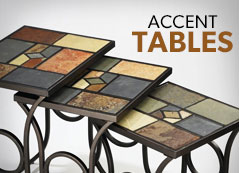
Different Types of Furnitures
In today's world when finding the right furniture style to fit in your home you will want to create a decor that fits your personal taste and will give you a complete look in regards to the style or styles you are choosing. Because there are so many options out there today's homes are more relaxed than ever about their stylistic choices where having one pure style is rare. There are two primary ways to think about furniture style, are Traditional styles that run along historic lines and two, Contemporary styles that make a simpler statement.
Traditional Furniture:
The main theme of traditional furniture is its historical influences. Traditional furniture are furniture styles that are based on historic design models and that are not contemporary. Traditional furnishings designs can come from eighteenth-century England, the French countryside, or even Eastern countries. Among the most popular traditional styles today are eighteenth-century English, nineteenth-century Neoclassic, French Country, and British Colonial Revival.
Eighteenth century English furniture was highlighted by style and craftsmanship. In America, colonial furniture was distinctly functional, often serving more than one purpose, simple in design, and heavy looking. As the wealth of the colonies increased, first in the South, so did the demand for quality furniture. Early 18th Century furniture was highlighted by objects like the bureau that incorporated mirrored doors, cabinets, and a writing flap. Chairs too were changing in dramatic fashion. Rather then having square shapes, they were evolving more curved and rounded in its look. The materials were also changing, with mahogany being imported from the Spanish. This replaced Walnut as the wood of choice. So instead of simple, bulky, and functional rural furniture, the European baroque and rococo styling-elegant urban designs in Queen Anne and Chippendale styles became very popular in large houses. Eighteenth century English furniture had its unique style featured in items like chairs, mirror, small tables, etc.
Nineteenth-century neoclassic furniture is a return to the art and architecture of classic Greece and Rome. The furniture designed in the Neoclassic style embrace bold, straight and linear lines, geometric shapes, and curves of the Rococo period which is a style characterized by grace, playfulness, and lightness. Later Neoclassic styles began to include Egyptian characteristics. Chairs had the neoclassic straight lines and the legs were fashioned into reeded columns.
French Country furniture will give you a look that is always rustic, old-world, and welcoming. French Country furniture fits well into country houses. The French Country style of decorating has a warm and casual feel that will fit beautifully into your home. Colors used to decorate in the French Country style come from the full spectrum of the color wheel. Yellow, gold, red, rust, green, blue and soft ocean tones are all these are found in this wonderful decorating style. Highlights of French Country furniture include delicate carved wood details and chair seats that have a simple look.
British Colonial Revival furniture comes from the Colonial Revival movement was a national expression of early North American culture. The Colonial Revival is generally associated with the eighteenth-century provincial fashion for the Georgian and Neoclassical styles. The movement inspired a variety of expressions to fulfill symbolic and functional needs during times of great change. The Colonial Revival was motivated by a range of historical events, particularly a rapidly growing industrial way of life and increasing immigration. Beyond its association with the development of a national historic consciousness that began in the 1870s, the Colonial Revival style in architecture, decorative arts, landscape and garden design, and American art has served to promote notions of democracy, patriotism, good taste, and moral superiority.
Other older styles include Mission Style Furniture which is a generic term often used to refer to Mission Revival Style of the Spanish missions located throughout the Southwestern United States and Mexico, or to the design elements of the American Arts and Crafts movement. The furniture built in Mission style is solid and built to last with no frills or needless embellishment. The simple designs of the Mission Style go against the extravagant designs of the Victorian era and also against the mass produced furniture emerging after the industrial revolution. They are known to be structurally sound pieces that emphasized the originality of the craftsman's work. The furniture pieces often include visible joints and the wood's grain is known to have a beautiful look. Nails and rivets were often left exposed to add a gleaming contrast to the wood or upholstery. Mission Style furniture is known to be very sturdy and it's the kind of furniture that is passed on from generation to generation. The Mission Style philosophy is often used in today's contemporary furniture. Clean, sharp geometric lines and a lack of ornamentation along with great craftsmanship are things that are present in much of today's furniture.
Contemporary furniture:
Contemporary furniture styles are modern styles, as in today's latest styles. Today's contemporary interiors are comfortable and welcoming without being cluttered and dark. It's a style that is equally appropriate for offices and stores, lofts and homes. To achieve the look of a contemporary home, it's important to stick to some basic rules. Simplicity, subtle sophistication, texture and clean lines help to define contemporary look of today. By focusing on color, space, and shape, contemporary interiors are sleek and fresh. Today's Contemporary furniture is known to be smooth, clean, and geometric shapes are essential for furniture pieces. Upholstered furniture often comes in black, white, or other neutral tones. Furniture pieces are simple and uncluttered, without curves or decoration. Sofas, chairs, and ottomans usually have exposed legs. Beds and chairs usually have no skirt, trim, fringe, or tassels. Pillows add a shot of color and texture in clean geometric shapes.
The family of contemporary furniture has many styles. Among them are Art Deco from the '20s, mid-century modern from the '50s, Scandinavian from the '60s, Italian from the '70s, and minimalism from the '90s. Whatever country they might be from, these contemporary ideas all come from one decade or other of the 20th century. Contemporary furniture is usually simple in shape and detail. Finishes and materials might vary. Contemporary pieces don't clash with one another. The more the pieces are usually the same vintage in shape, line, material and give a more serene decor to whatever room it is in. Contemporary furniture is easy to mix.
The highlight of the contemporary look is Art Deco. Art Deco was a popular design movement from 1920 until 1939, affecting the decorative arts such as architecture, interior design, industrial design, as well as the visual arts such as fashion, painting, graphic arts, and film. This movement was a combination of many different styles and movements of the early 20th century, including styles labeled as Constructivism, Cubism, Modernism, Bauhaus, Art Nouveau, and Futurism. Its popularity peaked during the 1920s. Art Deco focuses on elegance, dynamic design, bright colors, and expresses practical modernity.
Mid-Century modern is related to the Space Age. Its focus is that of a sleek, cool, yet accessible lifestyle. Mid-century modernism was more organic in form and less serious than the International Style. Scandinavian and Finnish designers and architects were very prolific at this time, with a style characterized by simplicity, democratic design and organic shapes. They had an influence on Mid-century modernism in the rest of the world, including the US. Mid-century modernism has become popular in recent times, and has influenced contemporary modern design profoundly.
Scandinavian Design emerged in the 1950s in the three Scandinavian countries Denmark, Norway and Sweden, as well as Finland as a design movement characterized by simple, uncomplicated designs, minimalism, stylization, functionality, and low cost mass production. Much Scandinavian Design makes use of form-pressed wood, plastics, aluminum or pressed steel.
Conclusion:
There are two primary ways to think about furniture style which are Traditional styles and Contemporary. Overall there are so many different styles and choices of furniture to choose from in fitting your home with the decor that fits your personal taste. Good luck on finding the perfect furniture to fit you and your family's style.




























